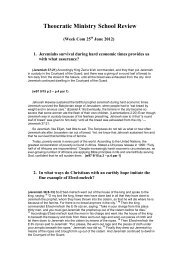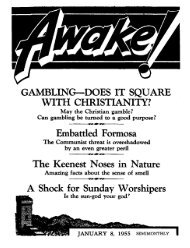1964 Awake! - Theocratic Collector.com
1964 Awake! - Theocratic Collector.com
1964 Awake! - Theocratic Collector.com
Create successful ePaper yourself
Turn your PDF publications into a flip-book with our unique Google optimized e-Paper software.
P·FFIT! What a<br />
tantalizing aroma! A<br />
can of mixed nuts has<br />
just been opened. Just<br />
look at them: jumbo<br />
peanuts, luscious bra·<br />
zils, tasty almonds,<br />
tangy pecans and<br />
sweet cashews. Some<br />
people prefer to pick<br />
out the cashews first. They like their salty<br />
sweet flavor, which adds flavor to all the<br />
other nuts.<br />
But do you know from where these tasty<br />
cashevvs <strong>com</strong>e? Did you know that they<br />
were once attached at the end of a pear·<br />
shaped fruit on a tree that may have been<br />
forty feet high? Would it surprise you to<br />
know that they were poisonous when<br />
picked? Yes, the cashew is a fascinating<br />
nut that you no doubt will enjoy learning<br />
more about.<br />
The Cashew Tree<br />
If you live in a tropical or subtropical<br />
climate you may be accustomed to seeing<br />
the spreading cashew evergreen tree, which<br />
usually grows to a height of from twenty<br />
to forty feet. Its large, four-inch·wide and<br />
six-inch-Iong, leathery green leaves pro·<br />
vide refreshing refuge from the hot tropi·<br />
cal sun. During its blooming period of two<br />
to three months it is adorned with clusters<br />
of bright pink, red, purple and white<br />
flowers.<br />
The cashew tree, first found in South<br />
America, was taken to Africa and India,<br />
where it now flourishes. In fact, cashew<br />
nuts have be<strong>com</strong>e one of India's major ex·<br />
22<br />
ports, some 100,000,000<br />
pounds being shipped to other<br />
countries per year. The United<br />
States receives about 80 percent<br />
of this trade.<br />
Besides yielding a deli·<br />
cious nut, the cashew tree<br />
produces an eatable fruit;<br />
it is called the cashew apple<br />
because of a slight similarity<br />
to the apple in taste. The way<br />
the nut and the apple grow to·<br />
gether on the same stem is in·<br />
teresting.<br />
The inch·long, kidneyshaped<br />
nut forms first at the end of the<br />
stem. You will notice from the illustration<br />
that there are some stems that have the<br />
nut, but on which the apple has not yet ap·<br />
peared. You will also observe, however,<br />
that the nut leaves a space two or three<br />
times its size for the forming of the red·<br />
dish or yellow-colored, pear-shaped apple.<br />
In time, when both the apple and the nut<br />
are mature, the nut gives the appearance<br />
of having been forcibly sunk into the lower<br />
end of the apple.<br />
Here in Venezuela during the months of<br />
January to March it is interesting to visit<br />
the blooming rnere.1J trees, as the cashews<br />
are called in Spanish-speaking countries.<br />
Since the formation of the nut and the ripening<br />
of the fruit are in different stages,<br />
you can see blossoms, green nuts and ripened<br />
fruit all at the same time during the<br />
producing period.<br />
Preparing the Nut<br />
The cashew nut has two walls or shells.<br />
The outer wall has a smooth, thin, glasslike<br />
surface, which, however, is quite strong.<br />
It is olive green in color Wltil it matures,<br />
at which time it be<strong>com</strong>es strawberry roan.<br />
Between this wall and t.he harder inner<br />
A WAKE I




